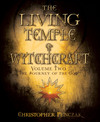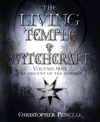The Gods of Witchcraft

When I got involved in Wicca, I found that most of my teachers emphasized the Goddess. Many people have been raised with traditions that emphasized the male aspect of divinity. These same people often come to nature-based religions with a desire to reconnect their spirit to the divine feminine, the Mother principle. I know I did. I came from a strict Catholic background, so I found the idea of the Goddess both intriguing and comforting. I always liked the Virgin Mary, and found the multifaceted images of the Goddess quite a wonderful challenge. It was hard to look at the feminine as not only virgin mother, but also sexual mother, warrior, crone, witch, healer, and reaper. Though it was a challenge, I found a building a relationship with the God to be an altogether a different experience.
Though many people think Wicca and Witchcraft are only about the Goddess, the God plays a pivotal role in most traditions. Most groups celebrate the union of Goddess and God. And while many emphasize the Goddess, and some exclude the God all together, most will look to both the Goddess and God of Witchcraft. Wicca and Witchcraft are traditions of balance, of both masculine and feminine energies. Practitioners are encouraged to recognize and develop both.
I had always had the image of God being a bearded man in the sky—distant and remote, ready to punish us at anytime. I read a lot of the Old Testament in Catholic School. Intellectually, I understood that God as a creative force, but this image was what I had for a personification. When I learned about the Witch's God, I got some very different images. Sometimes they were frightening, other times fatherly. Some were remote sky figures, others were earthly and sexual.
The God can be seen with three faces, much like the Goddess, but he has two dominant aspects. In fact, the God, is often strictly described as a dual god—a god of light and of darkness. The light god rules the waxing half of the year from Winter Solstice to Summer Solstice. The light god is sometimes called the Oak King. The dark god rules the waning half of the year from Summer to Winter Solstice. In Celtic traditions, the dark god is the Holly King. The Oak King and Holly King are said to fight at each solstice for control of the year. The Green and Red Knight legends, in which one battles the other, can be seen as a variation on this myth.
Light Gods
- Sun King: The Sun king starts as a small child at the Winter Solstice, but is associated with a mature man by Summer Solstice. Most Pagan traditions look to the Sun as male while the Moon is female, and associate the growing light with waxing God.
- Green Man: During spring, the God takes on an emerald hue, as the light of the Sun is photosynthesized in the green of the land. This God is one of vegetation, of the forest and the plants. Many believe the Green Man faces depicted in European churches were part of an effort by Pagan craftsman to keep Pagan traditions alive while the Church was in control.
- Sacrificed God: The Green God or Solar God is brought to a peak of power and then sacrificed on or after the solstice. This God is associated with the harvest of either grains or fruits such as grapes. When the harvest is cut, the waxing god is done and yields his power to the dark half. The sacrificed god is the light god with the darkest aspects because he represents the transition from one side to the next.
- Sky Father: The Sky Father image is one of either the benevolent father, or the distant patriarch. The figure of Zeus is probably the most well-known Sky Father from Pagan mythology. The Sky Father doesn’t partake in the light/dark cycle in the same way as the gods described above, but rather is the father figure who gives birth to the Sun God/Sacrificed God.
Dark Gods
- Horned God: The Horned God, from the Greek Pan to the Celtic Cernunnos, is the most beloved and misunderstood image of the Witch's God. He is the animal lord—a fertility god and the guardian of the gates between life and death. The Horned God was long ago corrupted into a fearsome image, but gods of horn were well loved throughout the world before the advent of Christianity.
- Underworld King: The Underworld King or Lord of the Dead is found in many mythologies, ruling over the unseen kingdom of the ancestors. Some, like Pluto, are also gods who rule over the riches of the underworld, making them patrons of wealth as well.
- Sea King: Many traditions look to the ocean as the underworld, or one gateway to it. The Sea King is not necessarily a dark figure. But, esoterically, water deals with the emotional realm. So does the underworld. This creates the link between these two kingly archetypes. In Roman mythology, Pluto and Neptune, Gods of the Seas, are brothers.
- War God: The Warrior Gods are not necessarily dark or underworld gods, but they are associated with some of the darker emotions we feel—including fear and anger. The true warrior path is one of discipline and courage, and some of these gods can teach the skills necessary to become a spiritual warrior.
Many gods don’t fit either the light or dark aspect. They are neither waxing nor waning forces. These gods are the male archetypal beings of the places in between. They are the bridge between the light and the dark. They are connective force. In myths, they often act as either guides to the gods, or instigators of their problems. They are the gods who are magicians and tricksters. Figures such as Hermes, Mercury, Thoth, Anubis, Odin, Loki, Gwydion, and Merlin would find their home in the places in between.
Meditation on the God
Get comfortable and set the mood for this meditation. Light some candles and incense. Sit in a comfortable position. Think of your intention to connect with the energy of the God, in whatever form he takes. Take a moment and ask for guidance and aid from your spirit guides and higher self. If feel connected to a particular form of the God, ask that aspect of the God to be present with you.
Close your eyes and count backwards from twelve to one. Twelve is a solar number, and associated with the god force. Imagine yourself before a tall hill or small mountain. See, feel, sense, and know that the hill is there. It's OK if you can't visualize things clearly. Just imagine it and go with your impressions. Sense that the hill of the Gods is there, and it will be.
Its height is a challenge, but not insurmountable. There is a pathway that guides you up, winding around the hill. Follow the pathway up. Climb higher and higher, taking notice of any rocks, plants, or animals that you encounter on your way. Each can be a sign for your journey. Certain stones can act as future talismans for you to work with this god. Plants may be in harmony with his energy, and help you reconnect. Animals can act as a guide or totem for you to return, and symbolize your connection to the God.
When you get to the top, you might find the God waiting for you on the summit. If you are meeting with a light god, or even an in-between god, he will usually meet you on the top of the hill and have a conversation with you, or guide you on a journey. Use your intuition and have confidence in your first impressions. Trust yourself, and trust your experience with the God. Let his words and pictures enter your consciousness effortlessly.
Or you might find a barrow, an opening that leads inside the hill, as if the hill was secretly a cavern, with a winding tunnel leading to its heart. There waiting for you in the center will be the dark god, in one of his many forms. He will speak with you and share his inner-world mysteries. Again, use your intuition and follow your first impressions. Open your heart to feel his message, in addition to processing it mentally. The dark god teaches on many levels.
When done, thank the God for whatever the experience was. Sometimes it is loving and gentle. Other times, it might force us to see things that we don't wish to, but need to witness for our own growth. (I know the God has been both for me.)
Return down the path and come back the way you entered. Retrace your footsteps. Do you see any of the same stones, plants, or animals? Take note of the ones that feature prominently in your perception. When you reach your starting point, count up from one to twelve and ground yourself. Open our eyes, stretch, and eat a little something if you need to. Write down your experience in a journal.
Many think the Goddess is always loving and gentle while the God is a stern taskmaster. But many times I've found the reverse is true. Simply let go of your expectations and know that the God is equally available to you in your path of spiritual development. He is simply waiting to be asked into your life.

About Christopher Penczak
Related Products


is subject to certain Terms and Conditions